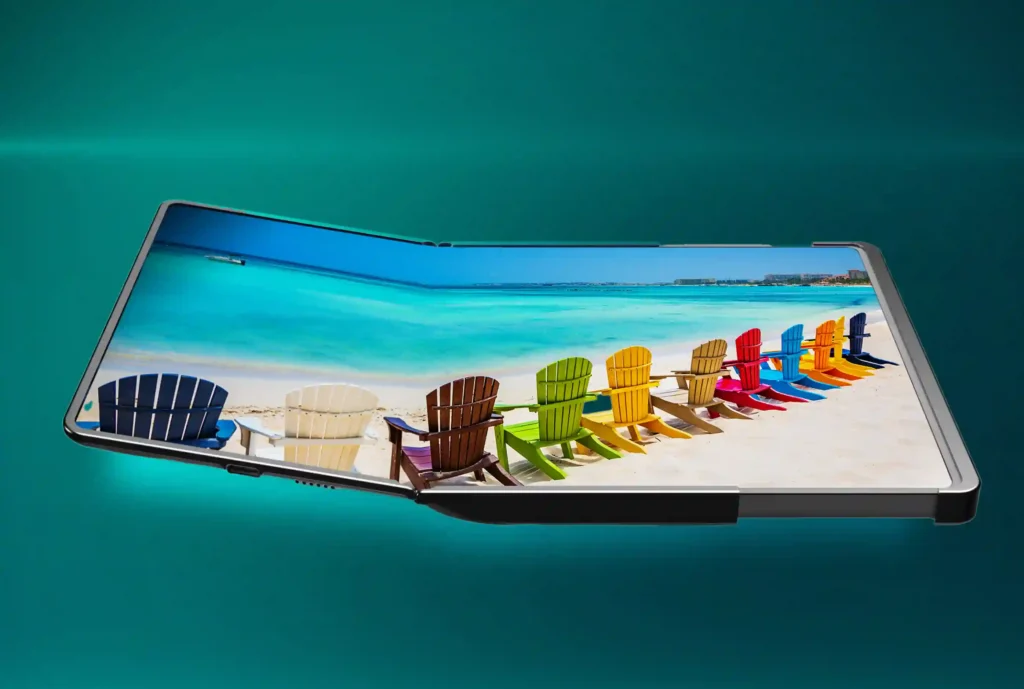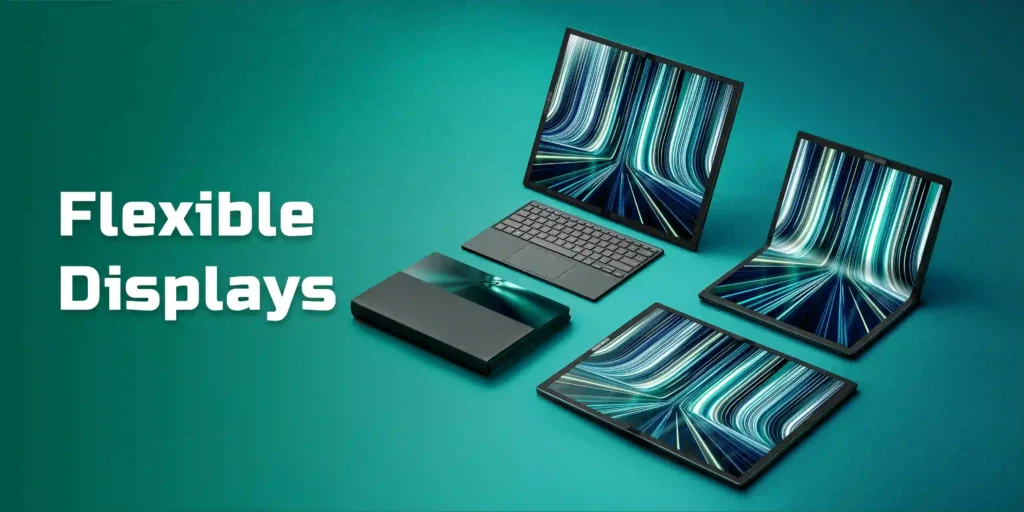Because of advancements in screen technology, flexible displays are completely changing the way we interact with electronic gadgets. This innovative screen can bend, twist, and fold without compromising the resolution of the display.
Introduction
Flexible displays are making industries, including consumer electronics, automotive, healthcare, and more, more viable. Consider a tablet or smartphone that can be rolled up into a small, portable size or that can be rolled up like a scroll.

These flexible screens provide customers with a more attractive and realistic visual experience as well as improved durability. With flexible elements available in wearable gadgets and curved TVs, the possibilities for this technology are virtually limitless.
We expect to see many more innovative items on the market soon as manufacturers work on expanding and improving flexible display technology. Watch attentively as the future of digital innovation is defined by these foldable screens.
How Flexible Displays Are Changing
The consumer electronics sector has experienced a transformation because of flexible OLED displays, which provide incredible innovation and versatility. The organic LED used in these displays enables screen bending, rolling, and folding with no damage to the display. For designers and engineers, this flexibility gives them an unlimited number of possibilities to develop never-before-possible products.
Flexible screens have a lot of advantages. Because they are more lightweight and thinner than traditional solid screens, they are perfect for wearables, tablets, and other portable electronics. along with using less power, flexible OLED displays produce sharper images with rich colours and great contrast levels.
There are many different and extensive uses for flexible displays. These screens are changing the way we engage with technology, from folding smartphones that can become tablets to curved televisions that provide an immersive viewing experience. Other creative applications include flexible e-readers that recreate the feel of paper books, smart clothes with integrated flexible displays, and even rollable screens for convenient transportation.
We can expect a wide range of products to come to the market soon as more businesses make research and development investments in flexible display technologies. The days of fixed screens are coming to an end, and in the new period that awaits in advance, flexibility will play a major role in defining consumer electronics.
The Science Behind Flexibility
The way we interact with screens has been completely transformed by flexible display technology, which provides incredible efficiency and adaptability. Advanced materials and technologies, that enable screens to bend and flex without sacrificing performance, are at the center of this revolution.
Flexible displays are made possible by polymers. Displays can bend and fold without breaking because of the large amount of flexibility that can be achieved by engineering these strong and lightweight materials. Flexible display technology helps manufacturers make screens that are lightweight, thin, and not subject to bending or twisting damage by using polymers.
When it comes to flexibility, OLED (Organic Light-Emitting Diode) is the better choice when compared to LCD (Liquid Crystal Display). OLED displays are thinner and more flexible to bend because they do not require a backlight like LCD panels do. OLED displays are perfect for applications that require a curved or foldable panel because of their flexibility.
The science of flexible displays is an interesting combination of modern technology like OLED and new materials like polymers. We can expect many more interesting advancements in the field of flexible display technology as these technologies continue to advance.
Real-World Applications and Success Stories of Flexible Display
The electronics industry has gone through a revolution because of flexible displays, which have made wearables and foldable smartphones possible. Flexible screens have also created some concern in the car sector because of their uses in improving safety features and user experience.
Samsung’s Galaxy Z Fold series, with its foldable display that blends tablet capabilities with smartphone comfort, is one notable success story. This innovative technology has changed the way people interact with mobile devices and created new opportunities for multitasking.
Flexible display integration has also proven beneficial for wearable displays, including fitness trackers and smartwatches. Because of the flexibility of the used display technology, these gadgets provide consumers with real-time data at their fingertips while keeping a modern and lightweight design.
Flexible screens are being used for dashboard displays in the car industry to give drivers access to critical information more logically and attractively. These flexible screens improve convenience and safety for drivers on the road, providing anything from navigation assistance to car monitoring.
Flexible display integration applications across a variety of industries highlight how this technology is improving user experiences and transforming our daily lives.
Challenges and Opportunities in the Evolution of Flexible Display
With its ability to create gadgets with bending panels, flexible display technology has changed the electronics industry. But for its mass adoption to occur, some obstacles come with its potential.
Maintaining the durability of bending components is one of the main issues facing flexible display technologies. Producers are always trying to come up with materials that are robust to folding and bending without losing quality. Making displays that are both adaptable and able to withstand regular usage is the goal.
The development of flexible displays also faces obstacles in the manufacturing process. Bendable screen production requires advanced techniques and expensive, specialized machinery. To lower costs and maximize production processes, manufacturers are always working to increase consumer accessibility to flexible screens.
For flexible display technology, the future looks bright even in front of these obstacles. As foldable screens achieve popularity, we will be viewing innovative functions and designs in devices like wearable technology, tablets, and smartphones. Creative product designs and improved user experiences are made possible by the move of foldable displays.
FAQS
OLED (Organic Light-Emitting Diode) and E Ink are two thin, bendable materials that are used in flexible displays. These materials can be twisted or folded with no damage to the screen. Innovative designs are made possible by these materials in gadgets such as e-readers, wearables, and cell phones.
Technology for screens that can twist, fold, or roll without breaking is known as a flexible display. Innovative designs in electronics are made possible by its ability to make small, lightweight screens that can adapt to different shapes, because of materials such as OLED and e-paper.
OLED (Organic Light-Emitting Diode) and AMOLED (Active-Matrix Organic Light-Emitting Diode) screens are two examples of multiple video display types that use flexible displays. These developments make it possible for frames to bend and twist, enabling up imaginative and flexible display applications.
Conclusion
Understanding the flexibility of display innovation provides many creative and useful possibilities. It will be interesting to see how flexible displays impact different business futures and improve user experiences on multiple platforms as technology develops. With an exciting path ahead, the search for creative solutions using flexible display technology is just getting started.
